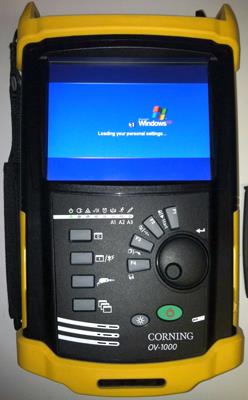
|
|
The Corning Cable Systems 1000-MAINF-VPM Optical Time Domain Reflectometer (OTDR) provides testing flexibility by combining a rugged platform with field-interchangeable multimode, single-mode and advanced testing modules. All OTDR modules can be used as continuous wave (CW) light sources. The mainframe has a power meter and visual fault locator (VFL). The 1000-MAINF-VPM utilizes Windows® CE technology allowing for a fast power-up time of four seconds. The OV-1000 has an 80 MB internal flash memory that typically stores up to 1500 traces and eliminates the need for a hard drive, which can fail under extreme field conditions. If extra storage capacity is needed, the unit offers USB A/B ports and a compact flash slot.
The 1000-MAINF-VPM offers a wide variety of multimode and single-mode modules. Modules are cross-platform compatible between the OV-1000 and the OptiVisor™ 400 OTDR mainframes. The 1000-MAINF-VPM has the capacity to hold up to two OTDR modules or one OTDR module and one advanced testing module at the same time. Modules can be easily switched out in the field, without the use of tools, in just a matter of seconds.
Specifications.
Display: Color touchscreen, 640 x 480 TFT 163 mm (6.4 in).
Interfaces: USB A main; USB B remote; RJ-45 LAN 10/100 Mb/s; compact flash; fiber inspection probe connector port (video).
Storage: Internal 80 MB (flash); USB sticks 1 GB and 2 GB (optional); compact flash cards (optional).
Power Meter.
Calibrated Wavelengths (nm): 850, 1300, 1310, 1490, 1550, 1625, 1650.
Detector: InGaAs.
Power Range (dBm): 10 to -86.
Uncertainty: ± 5% ± 3 pW (InGaAs).
Display Resolution (dB): 0.01 = max to -76 dBm; 0.1 = -76 dBm to -86 dBm; 1 = -86 dBm to min.
Automatic Offset Nulling Range: Max to -63 dBm for InGaAs.
Tone Detection (Hz): 270/1000/2000.
Visual Fault Locator (VFL).
Laser, 650 nm ± 10 nm.
Continuous wave (CW).
Typical Pout in 62.5/125 μm; 3 dBm (2 mW).
|